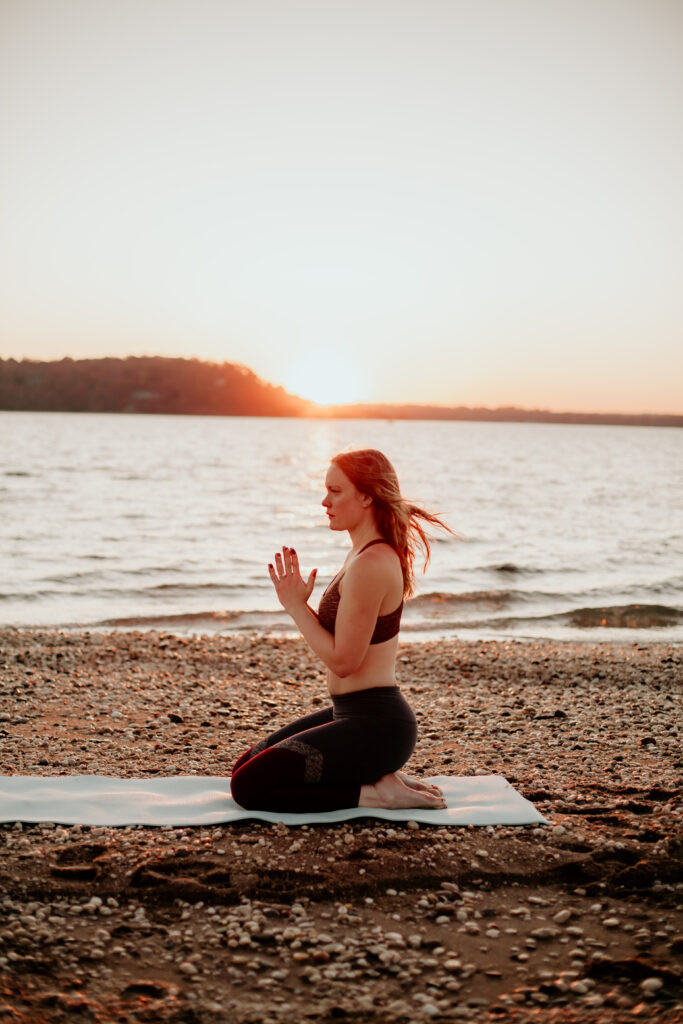As summer approaches, many people set a goal to get in shape for the warmer months. However, focusing solely on short-term results can lead to a cycle of yo-yo dieting and exercise patterns that ultimately fail to produce long-term success. Here are some reasons why just getting in shape for summer doesn’t work long term:
- Lack of sustainability: Crash diets and extreme exercise routines are often unsustainable and can’t be maintained in the long run.
- Neglects overall health: The sole focus on aesthetics neglects the importance of overall health and wellness.
- No long-term motivation: Once the summer ends, the motivation to maintain a healthy lifestyle often fades.
- Cycle of weight gain and loss: Yo-yo dieting and exercise patterns can lead to a cycle of weight gain and loss, which can be detrimental to overall health.
- Increased risk of injury: Extreme exercise routines can lead to burnout and injury.
- Disordered eating habits: Crash diets can lead to disordered eating habits and an unhealthy relationship with food.
- No focus on habits: Just getting in shape for summer focuses on short-term results, not the development of healthy habits.
- No focus on mental health: The emphasis on physical appearance neglects the importance of mental health and well-being.
To achieve long-term fitness success, it’s important to focus on making healthy lifestyle changes that can be maintained year-round. This means:
- Setting realistic goals
- Finding enjoyable physical activities
- Cultivating healthy eating habits
- Prioritizing overall health and wellness
- Focusing on developing healthy habits
- Prioritizing mental health and well-being
By shifting the focus from short-term aesthetic goals to long-term health and wellness, we can create a sustainable and healthy lifestyle that extends far beyond the summer months.
Everyone has a different level of love (or hate) for exercise. The closer you can come to at least liking, if not flat-out loving your workout, the better the results will be! The amount of enjoyment you get out of exercising is a predictor of how much you will actually do it.
If you have always been on the fence about exercising, chances are you are not truly enjoying your workout. Start with answering these questions about your workout:
- Are You a Creature of Habit or Do You Thrive on Variety? Whatever is true for your food, music and movie tastes will likely hold the same for exercise. If you are a creature of habit, you may be content with a run everyday. However, if you like to mix things up, you may want to run one day, strength train the next, and do yoga on alternating days.
- What is Your Goal? Identify what it is you want to accomplish. Set a goal such as improving cardiovascular health, getting stronger, or running a 10K. Get excited when each workout is bringing you closer to your goals. If it is not, chances are you won’t enjoy it as much.
- What Are You Good At? It is only human nature to enjoy the activities you are good at! The confidence in your exercise ability is a huge factor in how often you are likely to engage in it. Even exercise newbies will find a form of exercise they feel more confident in than others. Start with that form! As you gain confidence, you will likely want to further expand your horizons.
- Do You Like to Workout Alone or With Others? Some people value their alone time at the gym, while others feel they need social support. If an introvert, going on a solo run or lifting weights alone may help to clear your head. However, if you are an extrovert doing a group fitness class may be more fun. Small group sessions and 1:1 Personal Training sessions are possibilities as well to get some engagement.
- Do You Like to Be Indoors or Outdoors? Finding the right environment to support physical and mental health is extremely important. When it’s nice weather, multiple indoor workouts can be performed outside.
- What is Your Exercise Vibe? Do you prefer a high-energy environment or a calming yoga studio? Do you like a competitive setting or a more social environment? Do you prefer your instructor to be more inspirational, informative or a drill-sergeant?
Once you have answered these questions, it is time to experiment! Try any workout out that you think may be a fit, and give it THREE tries before ruling it out. Take this as a fun, learning experimental experience to see what works for YOU! If you haven’t tried a FREE trial of a workout (Live or on-demand) on my website, ask yourself these questions. Try the one that you feel best fits your personality.
Fitness goals require more than just simply picking a plan and going for it. To achieve the most success, focus on wellness habits you can start through a series of gradual increments. Trying to start a new habit or achieve a fitness goal with life-altering changes can lead to failure, frustration, injury or dropout.
Step 1: Creating Your Fitness Goal
In order to establish a general goal, determine the one thing — your limiting factor — that keeps you from achieving that goal. Do you want to get in better shape, lose weight or eat healthier? Remember, only action leads to change! “Don’t do X” is not an action plan. “Do more Y” is.
Now, take those general action statements and shape them into a fitness goal you can reach this year. Effective goals are SMART, or:
- Specific: The goal should identify a specific action or event that will take place.
- Measurable: The goal and its benefits should be quantifiable.
- Achievable: The goal should be attainable given available resources.
- Realistic: The goal should require you to stretch some but still make success likely.
- Time-based: The goal should state the time period in which it will be accomplished.
Write down your fitness goal in a spot where you will see it regularly. Research shows that people who take a few minutes to put their goals on paper are five to 10 times more likely to achieve them. So pull out a pen, paper and your sneakers and get started!
Step 2: Put Your Fitness Plan Into Action
With your long-term goal in mind, start looking at what you can do to now to make it happen.
Once you an identify what you need to work on and the skills you need to successfully achieve your long-term goal, break them down into realistic, smaller behavior-based goals. These will help hold you accountable and responsible for the changes you’ll make in your life.
Your short-term goals are like a domino effect. Each new habit should set off a positive chain reaction toward your long-term goal. Once you have been consistent for 14 to 21 days, pick another short-term goal. The goal is to practice simple, strategic actions that build up over time.
The New Year is a wonderful time to set some new goals. These goals should be SMART and attainable over time. No need to stress about a NEW YOU! Focus on goals first!
One of my main goals is to make it fun for women to prioritize regular physical activity in their lives. We know that even just 10 minutes of exercise a day can make a big impact on your physical and mental well-being. One of the most critical aspects of feeling good from movement, though, is consistency. Consistency is key to maintaining a healthy lifestyle.
If you are trying to learn how to stay consistent with working out, just know it isn’t always easy to workout every day. We all have days where we have a jam-packed schedule, the day gets away from us, or we simply just don’t want to workout. It is my goal to make your fitness journey manageable and enjoyable, even on those challenging days.
1. FIND A WORKOUT YOU LOVE
I know that it seems obvious, but it is so important to find a workout you look forward to doing. If you aren’t excited to do your workout, it will be much more difficult to follow through with it. Looking forward to and loving your workout will make it easier to maintain a consistent workout schedule.
2. FIND A WORKOUT BUDDY
Community and connection are a big part of life, and they extend to working out! Whether you find community through workout classes or schedule time to workout with your bestie (online or at home), finding workout buddies helps to hold us all accountable. Showing up for both your buddy and yourself makes it easier to get the workout session done on days when you’re just not feeling it.
3. TRY A SHORTER WORKOUT
I am a big fan of shorter workouts or mini workouts. On days when I really don’t feel like working out, I take a deep breath and tell myself that I can commit to just 12 minutes of movement. Every single time I do half of one of my 25 minute shorter workouts, I feel so much better. I usually end up finishing the 25 min workout OR saving the rest for later since my energy levels are so much better!
4. STREAMLINE DECISION MAKING
I am a big advocate for making things easy. I personally like to workout in the morning (when I teach), so I set out my workout clothes the night before so I don’t have to think about picking an outfit first thing in the morning. You can also set out your mat, weights, and have your iced coffee ready to go in the fridge so you don’t have to think about those things, too!
5. SET REALISTIC EXPECTATIONS
As you embark on your fitness journey, consider setting smaller, realistic goals on the way to your ultimate fitness goal. Instead of focusing solely on the end result, try shifting your focus to small victories, such as improving your workout consistency or increasing your strength. These smaller goals can act as stepping stones on your path to a healthier lifestyle, providing you with a sense of achievement along the way. Remember, the key to developing a consistent workout routine is building a workout habit. Consistency is the secret ingredient to reaching any fitness goal. Incorporating regular workout routines into your weekly workout plan can greatly assist in creating this habit. Don’t forget, it’s your journey, and it’s not about perfection, but about steady progress. Enjoy each step along the way and embrace the accomplishment of showing up for yourself!
6. CHOOSE MOVEMENT!
Even if we use all of these hacks to stay consistent, there are still going to be days where we just don’t have the energy to workout- and that’s okay! On these days, it is important to remember that movement doesn’t need to be a structured workout. Choosing to take a walk to grab a coffee, parking further away in the parking lot during your day of errands, and taking a break from work to do some stretching all help!
Feeling stuck? If you have never taken one of my classes (Live OR recorded), head to http://www.cgmfit.com and add a LIVE or RECORDING to your cart. At checkout use code WELCOMECGM to get the class FREE! Classes range from 25-50 min with multiple formats available!
As the days grow shorter and colder, many people struggle with the winter blues. Even though autumn and winter are filled with beauty and inspiration, they also can be challenging – especially for those who thrive in the sunnier seasons. The seasons have a notable impact on most of us, even if we don’t always realize it. Each season has its highs and lows, and each one is filled with valuable life lessons, but some seasons can be more difficult than others. If you find your mental health suffers in autumn and winter, here are some tips you might try to help make these seasons more enjoyable.
1. Venture outdoors
The lack of light and shorter days can make it tough to go outside, but if you’re feeling down, making the effort to spend time in the fresh air can really help. Even just a quick walk around the block can improve your mood.
2. Seek sunlight
Pull up the blinds! Open the curtains! The lack of sunlight is one of the reasons for feeling down during darker seasons, so the more sunshine you can allow into your home, the better. Going outside isn’t always an option, but take advantage of sunny days indoors by allowing the light in.
While I’ve personally never tried a light box, it’s on my wish list for this upcoming season because it seems like light boxes help a great deal for those with seasonal depression (or less serious cases of the winter blues). Apparently there are many different types (as well as something called a “dawn simulator” that’s used to wake you up in the morning) so be sure to do your research and figure out which one would be best for you.
3. Make some art
I know art isn’t everyone’s thing, but if you’re feeling down, give it a try. It doesn’t have to be traditional art either – try writing, pottery, drawing, painting, or sewing. Anything creative that allows you to get in a flow for a bit can help improve your mental state.
4. Practice yoga
Though I’m not particularly good at yoga (I generally do it only once a week), making even a little bit of time practice always makes me feel better, especially on extra gloomy days. If yoga isn’t your thing, any type of movement or exercise will be beneficial.
5. Make plans and stay connected
When I’m feeling down, the last thing I want to do is be around people. But I’ve discovered that it’s often what my mind needs when I’m feeling down. I don’t enjoy going out in the cold, but indoor activities can work, too (as long as you take proper precautions). If you can’t be physically with someone else, a quick phone call or video chat can also help when you’re battling the blues.
There are many options to explore if you’re struggling during the darker days, but hopefully some of these suggestions will help. If you find yourself suffering a great deal, it’s always good to seek out professional help (whether in the form of therapy or from your doctor). And if you’re struggling now, know that you’re not alone; it’s perfectly normal to experience down days during periods of change. Keep in mind that, even when it doesn’t seem like it, the difficult darkness will pass. Seasons always change, and the way you feel will change, too.

In today’s fast-paced world, it’s no surprise with the amount of stress present in so many lives. Persistent stress triggers the amount of cortisol released into our body. Cortisol is responsible for the fight-or-flight response, but chronic levels can take a toll on our health and well-being. There are many natural practical ways to lower cortisol and restore balance to our bodies for a more stabilized life!
Understanding Cortisol:
Cortisol is a stress hormone produced by the adrenal glands in response to stress signals in the brain. This hormone is known as the “flight-or-fight” hormone, which is involved in releasing energy stores, increasing heart rate and redirecting blood flow. If cortisol is constantly elevated, it can wreak havoc on the body.
What is the Impact of High Cortisol?
Over time, prolonged exposure to high cortisol levels can lead to very serious health issues. Elevated levels have been linked to hypertension, which placed strain on the cardiovascular system and increases the risk of heart attack and stroke. It can also contribute to insulin resistance, which can ultimately lead to type 2 diabetes.
Cortisol helps us wake up in the morning, but chronic stress can disrupt this pattern. This can lead to irregular sleep schedules or problems falling asleep. By implementing strategies to lower cortisol levels, you can positively impact your physical and mental health.
Tip 1: Prioritizing Sleep
Quality sleep plays a significant role in cortisol regulation. Establishing a consistent sleep routine, creating a comfortable sleep environment, and limiting screen time can all improve sleep quality. Get into a pre-sleep relaxing routine such as taking a warm bath, listening to a meditation, or reading.
Tip 2: Stress Management Techniques
Activities such as meditation, stretching and deep breathing can alleviate stress and enhance a calm state. All of these practices signal to the body that it is ok to relax, which will reduce cortisol production.
Tip 3: Regular Exercise
Engaging in regular physical activity will naturally reduce cortisol levels. Exercise will decrease stress, but also enhance mood. The best way to maintain levels are to switch the type of exercises you do. Perhaps one or two days you can do barre or Pilates, while the other few days are cardio with weights. Keep in mind that doing a lot of H.I.I.T. may increase cortisol levels in our bodies.
Tip 4: Incorporating Mindfulness Practices
Mindfulness techniques such as yoga can have a positive impact on cortisol levels. This encourages present moment practice, which will reduce the body’s stress. Another practice is mindfulness meditation, which involves focusing on the breath and observing thoughts without judgement.
Tip 5: Nutrition Strategies
A balanced and nutritious diet can contribute to cortisol control. Focus on fruits, vegetables, lean proteins , and whole grains. Incorporating Omega-3 fatty acids, which are found In fish and chia seeds, an also have anti-inflammatory effects on the body reducing cortisol levels.
Cortisol management is a holistic endeavor that encompasses physical, mental and emotional health. By prioritizing sleep, stress management, nutrition and exercise, you will be so much better suited to handle cortisol levels and lead a much more balanced life.
Is it ok to have drinks in moderation and also be a fitness fan? Surprise…the answer is YES! Researchers have found a link between people with high fitness levels and those who enjoy a refreshing alcoholic beverage.
When choosing a low calorie alcoholic drink, skip those mixed with simple sugar. Aim for vodka seltzers and/or tequila and lime. If you are trying to lose weight, decreasing the amount of calories consumed from alcohol can be extremely effective. Alcohol can be consumed in moderation with a balanced diet.
So what are the 5 drinks with the least amount of calories? Here they are:
- Vodka Seltzer- This is a classic drink made by combining vodka with unflavored seltzer or club soda. There is only about 133 calories in a 7.5 oz serving! Need more flavor? Try garnishing with cucumber or mint OR add a little lemon/lime juice. Alternatively, a flavored seltzer and/or sparkling water may just do the trick!
- White Wine-White wine generally has less calories than red. Typically, it contains about 123 calories in a 5 oz serving. There are so many varieties to try including chardonnay, sauvignon blanc, pinot grigio, and riesling. Bored of plain wine? Add some fresh fruit or mix in some sparkling water/seltzer to make a spritzer.
- Tequila with Lime- This is one of the easiest cocktails to make and the lowest in calories! A shot of tequila with a lime wedge has only about 99 calories. Is drinking tequila straight not for you? Try mixing in some club soda or mint for a low-calorie cocktail.
- Dry martini-A classic dry martini consists of gin and vermouth and is usually topped with olives. There is typically 2.5 oz. of gin and 0.5 oz of vermouth. This packs a low 185 calories! Want to decrease the olive calories? Opt for some orange bitters or a lemon wedge.
- Paloma-A paloma is made with tequila, lime juice, grapefruit juice, and club soda. Some recipes call for extra sugar, but you can decrease the sugar content by skipping this or using a natural sweetener instead. Here is one I LOVE with the link below :

There are multiple ways you can decrease the calorie content of your favorite alcoholic beverages. One way is to make your own drinks instead of using premade mixers, which tend to have high sugar and chemical contents. Instead of using sugar or syrup, opt for fresh herbs or the simple syrup pictured above. Try using more ice, sparkling water/seltzer and LESS soda or juice.
Regardless of whether you are trying to lose weight, alcohol should only be enjoyed in moderation as part of a healthy well-rounded diet.
DISCLOSURE: This post contains affiliate links. This means, at no extra cost to you, we make a small commission if you purchase a product through these links. As an amazon associate I earn from qualifying purchases. This helps to support CGM Fitness. Thank you!
Feeling tired and sluggish in the middle of your workday? Do you find yourself struggling to stay focused after lunch? So many of us experience this mid-day slump on a day to day basis. The great news is there are many strategies we can use to overcome this slump and power through our workday. Let’s explore some of these strategies here!

Move Your Body
Sometimes your body just needs some mid-day movement! Going for a quick walk after lunch may just give you that boost of energy you need to stay strong! Not in a walking mood? Do 1/2 of a 25 min recording and finish the rest later! Or just do the warm-up section of it, and complete the rest of the exercises after work.

Practice Mindfulness
The mid-day slump is often caused by stress and anxiety. Practicing deep-breathing, meditation, and EFT tapping are all techniques to reduce stress and increase focus. Bring your attention to your breathing and let your thoughts come and go. You will probably feel MUCH more refreshed after a couple minutes of deep-breathing.

Hydrate and Optimize Digestion
Sometimes your body needs extra nutrients. Having a nutritious snack may just be what you need to give you the boost of energy to keep going strong. Instead of reaching for sugary snack or caffeine, opt for snacks high in fiber an protein. Nuts, seeds, veggies and hummus, apples and nut butter, are all great examples. These will provide sustained energy to help feel more alert.

Socialize
Taking a few minutes to chat with a friend over the phone or a co-worker can definitely improve your mood and energy levels. Catch up with a family member and find out what is going on in their lives. Share a funny story with a co-worker to build better working relationships and lighten up your mood.
Prioritize Tasks
It is important to focus on the the most important and trying tasks when you have the most energy. Try to tackle the most difficult tasks at the start of the day and leave easier tasks towards day’s end. If after doing one of the tips above you feel you have more energy, try to add in some more challenging tasks! Continue on in this pattern until you can find your groove!
Our relationship to the world has been proven to impact wellness and wellbeing. Spending time outside has more benefits than just on our physical body. It can decrease stress, help with overall mental health, and maybe even strengthen our sense of connection to others.
Spending time outside has been shown to reduce stress, which in turn improves concentration. This will help with overall productivity during the day. Getting outside increases energy and vitality, and there are so many different ways of enjoying the time outdoors. Here are a few:
Sun Bathing:
Of course, don’t forget the SPF! If looking for a more relaxing way to enjoy the outdoors, this is more your jam. Whether outside reading a book, at the beach, or poolside, enjoying the sun for 1-2 hours will increase vitamin D and overall mood. Need to be more active? Go for a swim OR enjoy reading with alternating bouts of walking in your backyard/around the block. Just because it is so important, I will say it again: DO NOT forget the SPF. Ideally, 50 SPF for your body and 70 for face!
Forest Bathing:
Forest bathing is taking the time out to immerse yourself in a forest environment. It has been shown to improve cardiovascular, metabolic, and immune system functions. It has also been shown to help with depression and anxiety. One study even showed that those who forest bathe, have been shown to have decreased cortisol levels.
There are also long-term benefits shown as well: decreased hypertension, improved resting heart rate, and increased quality of life.
Never fret if you do not live in the countryside. Time spent enjoying green spaces in a park or even short getaways can make the same impact. Even laying in the park and gazing up at the sky and trees have been shown to elevate mood, reduce blood pressure, and slow the respiratory rate.
Plant a Tree/ Grow a Plant:
Running not appealing to you? You can still find a connection to the outdoors! Whether growing vegetables, plants, trees, or flowers, growing something has been shown to increase overall wellbeing.
Tending a garden does not just foster more of a connection with nature, but can give a sense of achievement and appreciation of the beauty of the garden itself. Gardening has been shown to reduce depression and boost overall mental health.
No access to outdoor space? Grow something inside or get a window garden! This has been shown to boost overall satisfaction, improve creativity, and even help those with PTSD symptoms.
Conclusion:
There are so many beautiful things our planet can bring into our lives. Get outside and take the time to experience them! Connecting to the natural world can give us the sense that we are part of the greater whole! This will elevate our mood, improve our outlook on life, and increase our overall wellbeing.
Our day-to-day lives combine multiple responsibilities such as careers, maintaining a household, and balancing relationships. In the midst of all of this, it is crucial we take care of our physical health. Building a strong core is not just for our physique, but can unlock multiple benefits that impact our overall wellness and physical fitness.
Defining The Core
Before going into the benefits of a strong core, what does it refer to? It’s definitely more than just abdominals. The core includes the muscles in your abdomen, back, hips and pelvis. Here are 4 benefits of keeping a strong and healthy core:
1. Improved Balance and Stability:
Do you find yourself feeling unsteady in your workouts? A strong core can improve your balance and stability! You will develop better body awareness and control by strengthening the muscles around your spine, hips, and pelvis. Not only will you get a confidence boost, but you will be able to perform exercises that require balance, such as agile movements or yoga poses.
2. Enhanced Workout Performance:
A strong core serves as the foundation for all physical activities. You will be able to generate increased power and more efficiently transfer energy throughout your body when your core muscles are engaged and stable. Whether running, dancing, weight training, or doing yoga, a solid core will provide a stable base. This will optimize your performance and reduce the risk of injury.
3. Improved Posture:
Maintaining good posture is vital for physical health and confidence. Strong core muscles prevent slouching, support your spine, and promote natural alignment. When performing core exercises, you will naturally strengthen the muscles responsible for maintaining proper posture. This will lead to proper spinal alignment, decreased back pain, and a more confident appearance!
4. Injury Prevention:
An essential component of injury prevention is a strong core. By developing a stable core, you will minimize strain on your back. A strong core is similar to a shield which will reduce muscle imbalances, common injuries, and lower back pain.
Strengthening your core is NOT just about physical appearance. It is about improving stability, balance, performance, and overall fitness. Embrace core strength and you will feel an inner transformation that will not only help you during your workouts, but your everyday life!
